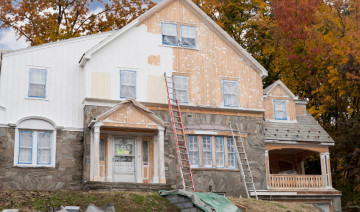
Top 6 Exterior House Painting Tips
A new coat of paint can immediately refresh and rejuvenate your house if done well, but if done poorly, that new paint job may become an instant regret. Whether you choose to paint your home yourself or hire a professional painter, these top exterior home painting tips can ensure a lovely look so your home will quickly become a star in the neighborhood.
DIY or Professional Painter?
Before starting to paint your home, you must decide whether you can handle the job yourself or if it would be best to hire a professional. While painting may seem like a simple task, the textures of your home’s exterior can make it more challenging, especially if you have larger home or one with more complicated architecture. Also consider that a professional will have access to the best equipment, including ladders and lifts if needed, as well as sprayers and other tools to apply the paint in the most efficient, consistent way. A professional painter will also be able to work with unexpected circumstances, such as sudden poor weather or other difficulties, yet still achieve a fine result for your home’s best appearance.
If you do hire a professional, ask for a portfolio or sample addresses of their work so you can judge the quality and outcome, and thoroughly discuss the work contract so you are aware of what other expenses may be added to the total before the job is complete. Be aware of the overall timeline for the job, including what impact inclement weather may have on the work, so you understand what to expect as the project gets underway.
Top 6 Exterior House Painting Tips
Whether you paint your house yourself or hire a professional, these top tips can ensure an excellent outcome that will help your home look its very best.
- Choose Colors Carefully
If you are changing the colors of your house, consider not only your favorite shades, but also colors that will look nice with seasonal changes in your landscaping. Also note the colors of your neighbors’ homes to avoid too much similarity, and think about how different colors will look in different light levels throughout the day. If you live in a home owners’ association (HOA), also be aware if color choices must be approved or you could face fines or need to repaint.
- Prep Before Painting
The bulk of work in painting the exterior of a house comes before you ever open a paint can. Scrape off old paint if needed, and pressure wash the house to remove dirt, dust, mold, or pollen that may keep paint from adhering. Take steps to protect your landscaping from paint and equipment, and cover light fixtures, windows, nearby fences, the driveway and walkways, and other areas from overspray or potential spills. Prime the surface if necessary.
- Make Necessary Repairs
If your home’s exterior has cracks, chips, or other damage, those repairs should be completed before painting. This will allow you to properly maintain your home and the paint will provide the final, finishing touch for a cohesive and flawless look. Check for loose siding, inadequate caulking, protruding nails, loose vents, and other needs before beginning to paint, and ensure the repairs are firm and final before moving on to the painting.
- Work With the Weather
Poor weather can wreak havoc on house painting, making it difficult for paint to stick or cure properly, or making the painting experience a miserable one. Early summer and early fall are the best seasons to paint, as the weather is generally drier and not too hot for extended hours of outdoor work. Furthermore, longer daylight hours will permit more work to be done when light levels are adequate to see the fine details for a job well done.
- Paint the Whole House
Even if only one side of the house shows wear and discoloration, it is important to understand that all paint fades in time, especially when exposed to constant sun and weather. For the best look, your whole house exterior must be painted or else discoloration and fading will be much more noticeable, even if the new color is the same as the original paint. If necessary, use multiple coats of paint to ensure a consistent finish.
- Maintain the Paint Job
Painting your house’s exterior doesn’t stop once the paint dries. The paint job must be maintained to look its best for years to come, which means regular cleanings to remove bird droppings, dirt, pollen, and mold. Be sure sprinklers are adjusted so they will not constantly spray the house, and keep pets from using corners or walls as potty spots. Trimming plants away from the walls will also help prevent scratching and discoloration over time.
Your home is a huge investment, and it is worthwhile to take great care when painting the exterior to keep it looking fine and fresh for many years. By doing the job properly and thoroughly, your home will look new and crisp in every season.


















